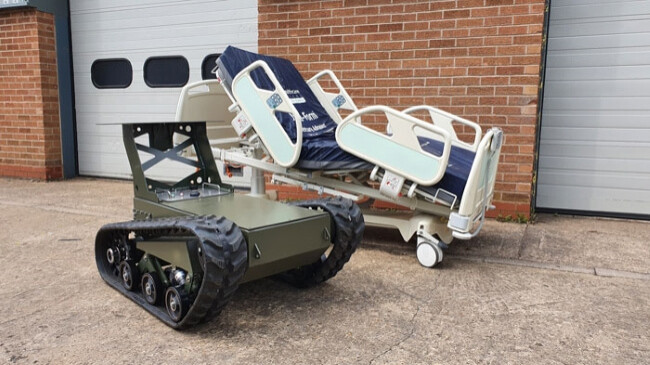Self-Driving Hospital Beds
| 21-07-2020 | By Robin Mitchell
Digital Concepts Engineering has demonstrated its latest self-driving hospital beds to help the fight against coronavirus. What are self-driving beds, what technologies do they utilise, and how will they help change the very fundamentals of hospitals?
COVID-19 and Tech
While government inaction and poor research are contributing factors to the sudden spread of the COVID-19 virus, the main contributing factor is the highly contagious nature of the virus itself. The ability for the virus to spread is also amplified by the fact that the human genome has never interacted with this virus type meaning that no natural immunity existed before its introduction. Initially, it was believed that the virus used physical contact and sneezing to spread. However, recent evidence is suggesting that the virus is also airborne, which explains how the virus is still spreading during the lockdown.
During the initial spread of the virus, governments around the world constructed dedicated temporary hospitals in anticipation of large numbers of COVID patients. Such a move helps to keep hospitals free from highly infectious viruses and ensure that it can continue to serve other health issues such as surgeries, cancer treatments, and general check-ups. However, even when COVID patients are confined to a specific centre, the risk to staff must be minimised otherwise staff may bring the virus outside the centre, further infect the population, and become ill themselves. Thus, exposure to the virus must be reduced at all times.
Old Practices
One method to reduce exposure to pathogens is to use air-tight PPE utilising positive air pressure. While this does help to prevent exposure, it is expensive to maintain and difficult to dispose of. The next alternative is to use masks, overalls, and gloves, which can prevent the spread of the virus but puts staff at higher risk of infection. This risk can be minimised by observing social distancing, but the staff that move patients around have no choice but to get within 2 meters of the patient to reach the bed. How can this social distance be retained, and what technologies that currently exist would allow for such a system?
Self-Driving Systems - From Autonomous Vehicles to Hospital Beds
The answer to such a problem may lie in technology that has existed in automated warehouses for the past decade: self-driving system. Unlike roads where autonomous vehicles have become increasingly popular, hospitals are hardly busy with very clearly defined routes. This leads to the possibility that a hospital bed can be automated when needing to go from one location to the other. A range of technologies currently exists to allow such a system including the use of invisible paint on floors to indicate paths, or the use of asset tracking and LIDAR, a laser light method for measuring distances and measuring reflections with sensors.
This is what Digital Concepts Engineering, DCE, have achieved by using their experience in the military, agricultural, and nuclear industries. In response to several porters dying from COVID-19 as a result of moving patients, DCE developed a self-driving hospital bed that allows for the easy transportation of highly infectious patients. Their self-driving robotic system can retrofit itself onto any hospital bed which provides hospitals with a double whammy. The first is that the ability to retrofit means that beds do not need to be replaced with an entirely new system. The second is that a system which can attach and detach itself to a bed allows for a hospital with many beds to operate only a few systems. Like a lorry, the robotic systems simply move their cargo, patients, from one place to another without the need for any staff. Achieving this driverless technology was only possible thanks to the companies experience in unmanned ground vehicles used by the military and nuclear industries. The self-driving system can navigate corridors and avoid objects while following a lead nurse who can keep a safe distance from the bed.

DCE’s self-driving hospital beds.
Credit: Digital Concepts Engineering
“First of all, we will be producing a system that will retrofit to any hospital bed, which will allow the beds to be moved around by a small powered unit. We will also be applying some of our control system expertise and other stuff that we’ve been working on the robotic vehicles. It’ll allow beds to follow the nurse around the hospital so that the nurse can focus on giving the patient the care that they need.” - Lionel Nierop, director at Digital Concept Engineering
Conclusion - Self-Driving Hospital Beds and Other Health Tech
The use of self-driving systems will drastically help with containing the spread of contagions in medical environments. This is important not just for the safety of staff, but also for the protection of potentially vulnerable patients. Such technology will also become important in GP practices which, for reasons I still don’t understand, has potentially contagious people sitting next to each other in the same room. COVID-19 may help to show the backward practices of medical staff, and how technology can significantly improve the ability to contain diseases that can cause massive economic and social disasters.

